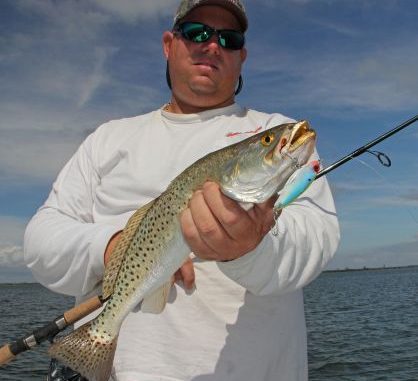
When winter pushes trout and redfish into deeper canals and inner marsh arteries, suspending baits often earn the attention denied to sinking and faster-moving baits.
This time of year, Venice’s Capt. Anthony Randazzo targets holes of 8 to 20 feet, where water temperatures remain more stable. And in these scenarios, Randazzo slowly reaches down to the fish with a MirrOlure Heavy Dine (denser version of the MirrOdine).
“We can allow (the heavier baits) to sink all the way to the bottom and slowly work them in a ‘walk the dog’ fashion back to the boat,” Randazzo said. “This allows us to cover the entire water column and find out where the trout are holding as the water temperature and barometric pressure relocates them on a daily basis.
“The fish may strike on the descent or on the retrieve. Fishing slower than normal is the most important thing to remember in these colder conditions.”
Other productive options include Rapala’s Twitchin’ Rap, Yo-Zuri’s Ma Darter and MirrOlure’s Catch 2000, while soft-bodied suspenders like Paul Brown Originals and Devils also deliver.
“Suspending baits work extremely well in cooler conditions when fish may not be feeding on top of the water,” said MirrOlure president and avid inshore fisherman Eric Bachnik. “The suspending baits will stay in the strike zone longer, you won’t (snag) any of the grass or substrate, and your hookup ratios are better.”
Braided line in the 20-pound range is sufficient for the inshore scene, while a short piece of 20- to 30-pound fluorocarbon leader conceals the braid and sinks with the bait. For unleashing your suspending bait’s potential, always use a loop knot to enhance the action.
“You want to use more of a twitching retrieve than a reeling retrieve,” Bachnik said. “You don’t want that lure to advance too far forward — you want it to dance from side to side or walk-the-dog below the water’s surface.”
And don’t hesitate to assign your suspending bait backup duty. Fact is, when a fish misses a topwater, the appearance of a bait hanging or slowly descending in the water column looks like the prey they just targeted is now falling into prime vulnerability.
Similarly, if you spot game fish rising behind your surface plug, but turning away at the last minute, they might just not be in the mood for breaking water. Switching to a subsurface display can turn lookers into takers.


